-
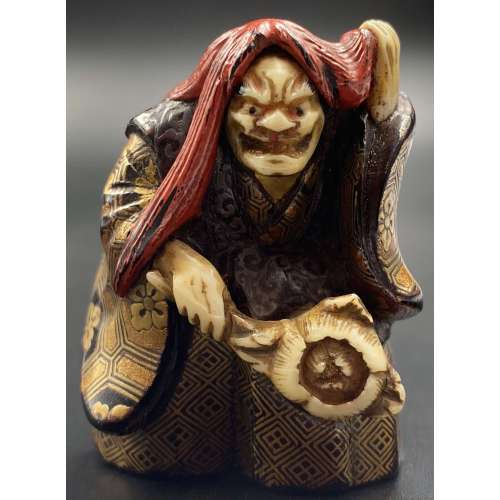 An actor dressed as a witch, with red hair, a gold patterned costume with tortoiseshell and flower lozenge design, and an inlaid ivory mask, hands, feet and flower blossom. Signature to the bottom: Kogyoku [光玉]. Dimensions: 4.17 x 3.07 x 2.99 cm. Provenance: Collection of Gloria and Joe Kurilecz. Sold by Eldred's, on August 25, 1993, Lot #699.
An actor dressed as a witch, with red hair, a gold patterned costume with tortoiseshell and flower lozenge design, and an inlaid ivory mask, hands, feet and flower blossom. Signature to the bottom: Kogyoku [光玉]. Dimensions: 4.17 x 3.07 x 2.99 cm. Provenance: Collection of Gloria and Joe Kurilecz. Sold by Eldred's, on August 25, 1993, Lot #699. -
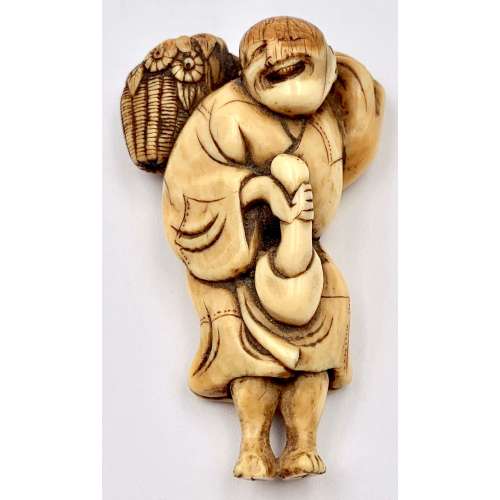
Netsuke with a design of a laughing peasant carrying a basket and holding a giant mushroom in his right hand.
18th century Dimensions: 55.7 mm tallUnsigned. According to Merrily Baird (Symbols of Japan, page. 93): ... This prominent use in the symbol-rich netsuke art form, however, reflects more their sexual symbolism than either their dietary appeal or interesting shapes. Mushrooms in Japan are generally a symbol of fertility, with some flat varieties, like shiitake, being associated with females. In contrast, the matsutake mushroom (Armillaria edodes) is a phallic symbol, as befits its thick, spearlike stem and the fact that it is consumed before cap opens.
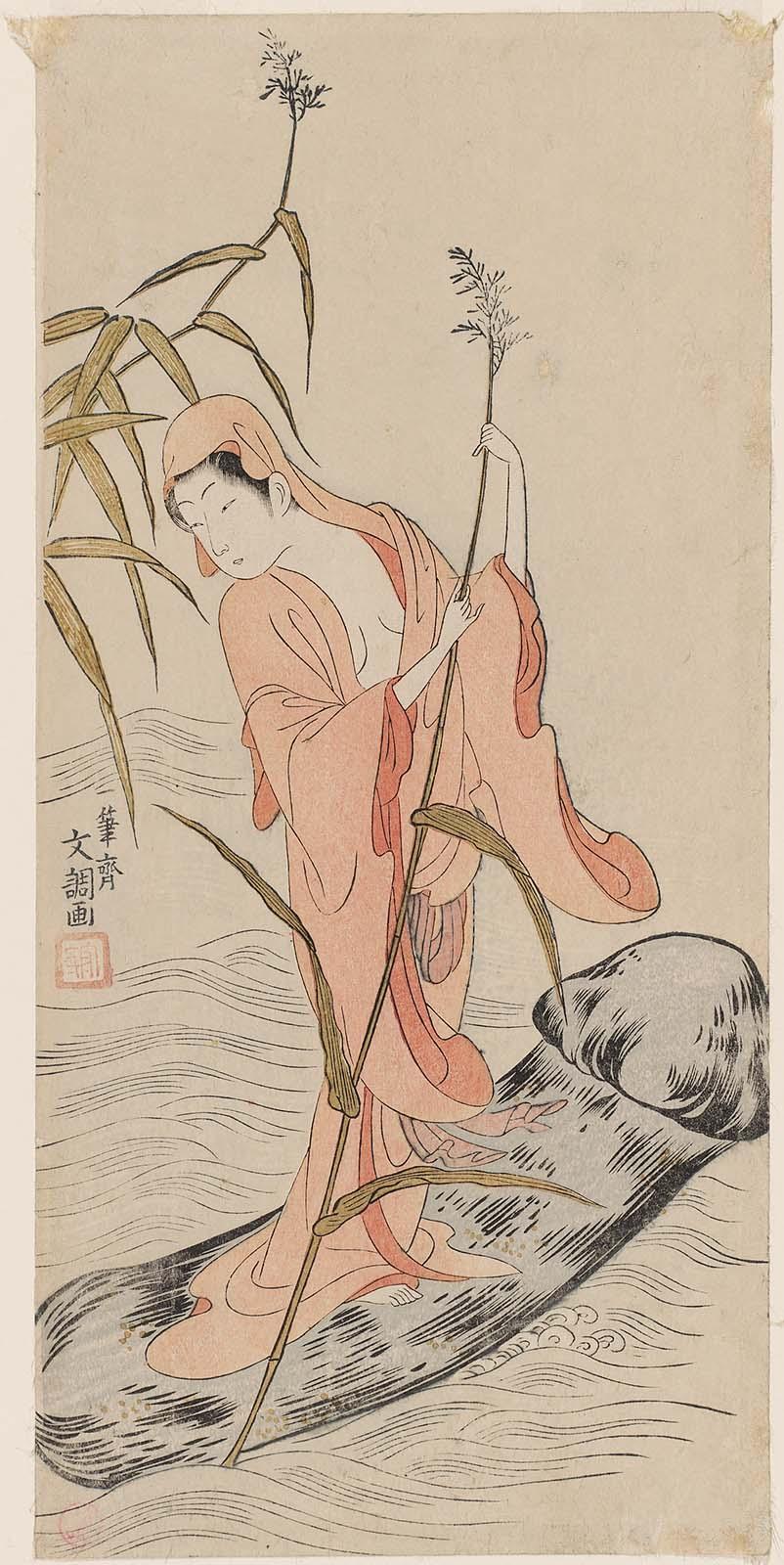
Female Daruma Riding a Mushroom [女達磨]. Ippitsusai Bunchô (1765–1792). MFA impressions: 11.18513, 21.4758
-
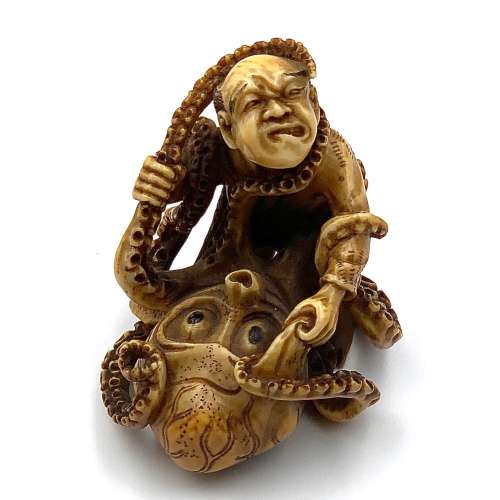
Ivory netsuke with a design of a man (possibly - Ariōmaru) wrestling a giant octopus.
Circa 1850. Dimensions: 45.5 x 48.3 x 37.8 mmUnsigned.
-
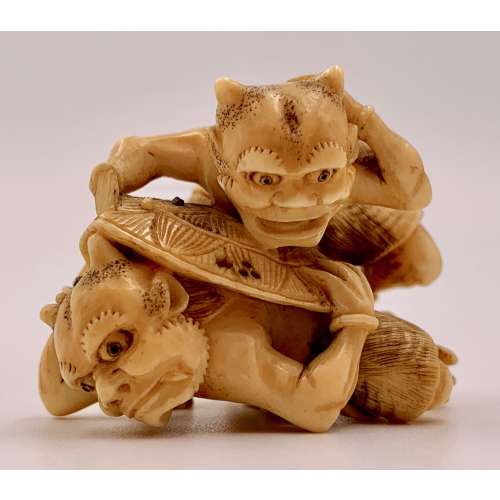
Ivory netsuke with the design of wrestling Oni by Kaigyokusai Masatsugu [懐玉齋正次].
Signed: Masatsugu [正次] Osaka School. Made: 1850-1900; Late Edo - Meiji Period. Dimensions: 44 x 40 x 33 mm.The right hand of the upper Oni and one toe of the lower Oni are missing. Ref.: Raymond Bushell. Collector's netsuke. Weatherhill, NY, Tokyo; Ninth printing, 2002, pp. 84-87. "Kaigyokusai Masatsugu (1813-1892) was an Osaka based carver renowned for his flawless technique as illustrated upon this netsuke with its finely carved ivory form, with no staining and bright inlaid eyes" (V&A).
-
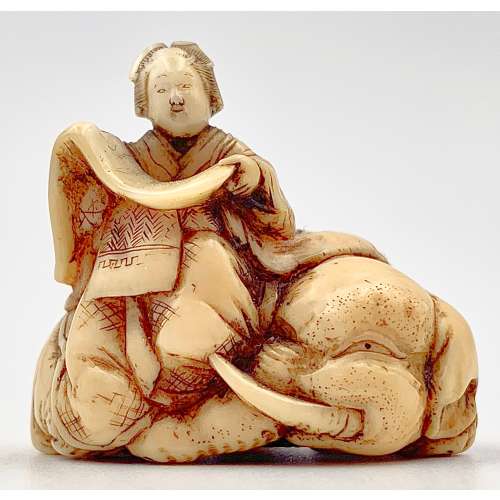 Netsuke of Kimi no Eguchi on a recumbent elephant. Signed: Toun. Circa 1850. 33.7 x 30.8 x 22.7 mm. The Courtesan Eguchi no kimi as Fugen, Bodhisattva of Universal Wisdom (Eguchi no kimi mitate Fugen Bosatsu). The imagery satirizes the Buddhist bodhisattva Fugen, whose iconographic mount is an elephant, by replacing the deity with a beautifully coiffed modern courtesan. Such a visual pun (mitate) was an artistic trope, popular in the Edo period. Provenance: Charles Ephrussi (1849-1905) acquired in the 1870s; a wedding gift in 1898 to his cousin Ritter Viktor von Ephrussi (1860-1945) and Baroness Emilie (Emmy) Schey von Koromla (1879-1938); retrieved post-war by their daughter Elizabeth de Waal (1899-1991); given by her to her brother Ignaz (Iggie) Ephrussi (1906-1994), Tokyo; bequeathed by him to his great-nephew Edmund de Waal (born 1964), London, author of "The Hare with Amber Eyes: a hidden inheritance". London / New York: Chatto & Windus / Farrar, Straus & Giroux. ISBN 978-0099539551. https://en.wikipedia.org/wiki/Charles_Ephrussi. https://en.wikipedia.org/wiki/Ephrussi_family. https://en.wikipedia.org/wiki/Edmund_de_Waal.
Netsuke of Kimi no Eguchi on a recumbent elephant. Signed: Toun. Circa 1850. 33.7 x 30.8 x 22.7 mm. The Courtesan Eguchi no kimi as Fugen, Bodhisattva of Universal Wisdom (Eguchi no kimi mitate Fugen Bosatsu). The imagery satirizes the Buddhist bodhisattva Fugen, whose iconographic mount is an elephant, by replacing the deity with a beautifully coiffed modern courtesan. Such a visual pun (mitate) was an artistic trope, popular in the Edo period. Provenance: Charles Ephrussi (1849-1905) acquired in the 1870s; a wedding gift in 1898 to his cousin Ritter Viktor von Ephrussi (1860-1945) and Baroness Emilie (Emmy) Schey von Koromla (1879-1938); retrieved post-war by their daughter Elizabeth de Waal (1899-1991); given by her to her brother Ignaz (Iggie) Ephrussi (1906-1994), Tokyo; bequeathed by him to his great-nephew Edmund de Waal (born 1964), London, author of "The Hare with Amber Eyes: a hidden inheritance". London / New York: Chatto & Windus / Farrar, Straus & Giroux. ISBN 978-0099539551. https://en.wikipedia.org/wiki/Charles_Ephrussi. https://en.wikipedia.org/wiki/Ephrussi_family. https://en.wikipedia.org/wiki/Edmund_de_Waal. -
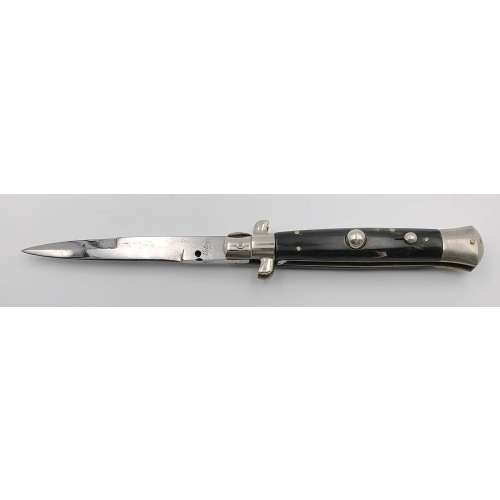
Classical picklock Italian stiletto switchblade knife with bolster release, fixed guard, Brazilian horn handle.
Size: 112 mm (closed); 240 mm (opened); 90 mm blade.
Tang is etched with: Latama, Italy. SOLD -
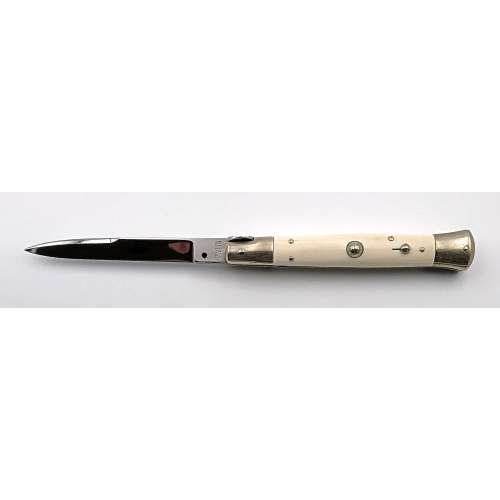
Classical picklock bayonet switchblade knife with bolster release, fixed guard, cream handles (ivory?).
Size: 123 mm x 20 mm (closed); 220 mm (opened); 130 mm blade.
Tang is etched with: Havlin. -
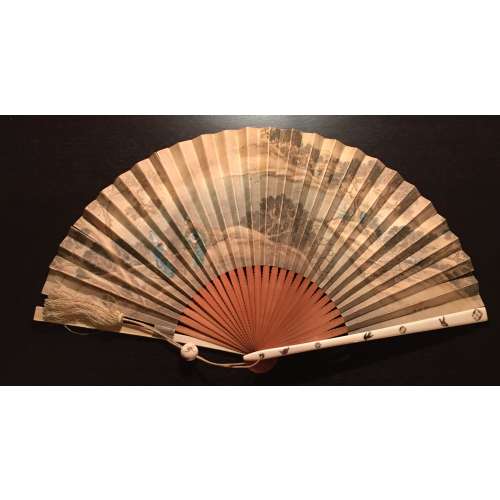 Late 19th-century (1850-1870) Japanese export fan. This fan has a double leaf painted with a different design on either side. Ivory encrusted with gemstones (birds and shippomon motif). Painting by ukiyo-e artist and printmaker Katsushika Isai (1821–1880) represents a riverside landscape with figures; birds and flowers on the reverse. Signed: Isai ga (為斎画) - "Painted by Isai".
Late 19th-century (1850-1870) Japanese export fan. This fan has a double leaf painted with a different design on either side. Ivory encrusted with gemstones (birds and shippomon motif). Painting by ukiyo-e artist and printmaker Katsushika Isai (1821–1880) represents a riverside landscape with figures; birds and flowers on the reverse. Signed: Isai ga (為斎画) - "Painted by Isai". -
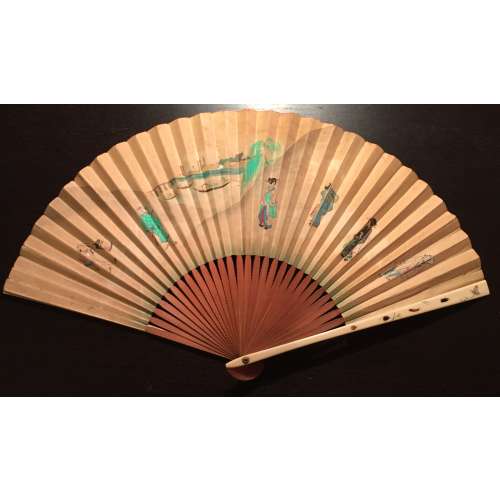 Late 19th-century (1850-1870) Japanese export fan. This fan has a double leaf painted with a different design on either side. Ivory encrusted with gemstones and other materials. Subject matter such as women wearing kimono is also more typical of export than domestic products (V&A). Summer (birds and flowers) theme on the reverse.
Late 19th-century (1850-1870) Japanese export fan. This fan has a double leaf painted with a different design on either side. Ivory encrusted with gemstones and other materials. Subject matter such as women wearing kimono is also more typical of export than domestic products (V&A). Summer (birds and flowers) theme on the reverse. -
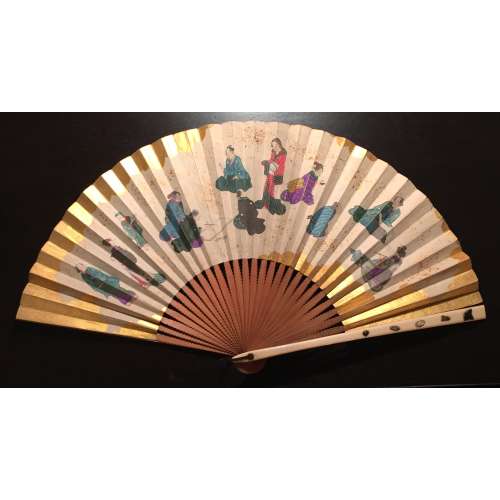 Late 19th-century (1850-1870) Japanese export fan. This fan has a double leaf painted with a different design on either side. Ivory encrusted with gemstones and other materials. Subject matter such as women wearing kimono is also more typical of export than domestic products (V&A). Autumn theme on the reverse.
Late 19th-century (1850-1870) Japanese export fan. This fan has a double leaf painted with a different design on either side. Ivory encrusted with gemstones and other materials. Subject matter such as women wearing kimono is also more typical of export than domestic products (V&A). Autumn theme on the reverse.


